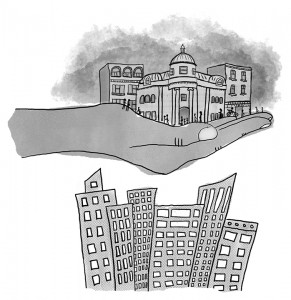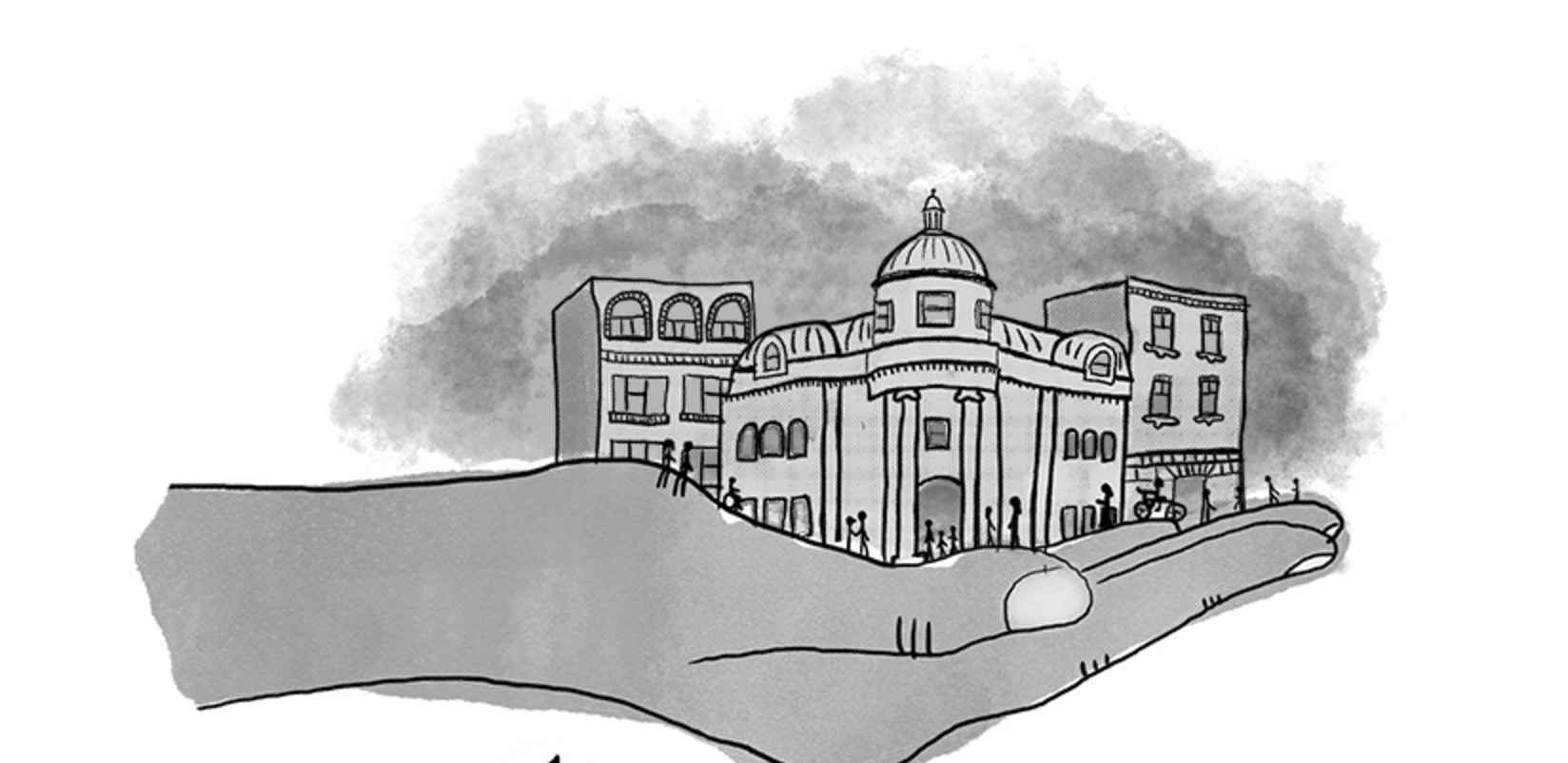“Gentricide.” There it is, written in fading red ink in an alley alcove in Vancouver’s Downtown Eastside, a combination of the words ‘gentrification’ and ‘genocide.’
No one has felt the mounting tide of housing insecurity more than the folks living at and around the intersection of Main and Hastings. It is the intersection where poverty and addiction disproportionately impact displaced Indigenous communities, first-generation immigrants, former Riverview Hospital residents, and many differently abled bodies.
While the neighbourhood demographics have changed, it was reported in a City of Vancouver area profile in 2013 that people living in the DTES had the lowest income in all of Canada, outside the Reservation System. The DTES community, as a whole, has faced an epidemic of opioid-related deaths, cuts to community resources, shifts from trusted community-based services to paternalistic and high-barrier agencies, and housing loss. Over the last few years in particular, the neighbourhood has been encroached by boutique condo developments and high-end-niche businesses aimed, in part, to change the demographic of the DTES and take advantage of its desirable real estate. Within this context of commodification and commercial interests, it is difficult not to jump to paranoid conclusions about how the ever-accelerating gentrification of the DTES has been made possible. Are there political or corporate forces that have deliberately calculated the vulnerability of people living in the DTES, and are allowing it to continue unnecessarily?
There is no evidence of inactive and ineffective government more damning than as demonstrated through Paige’s Story, a report released in May 2015 by independent watchdog and former Representative for Children & Youth, Mary Ellen Turpel-Lafond. Paige, a young, legally blind Indigenous woman, grew up in the Downtown Eastside, where she experienced violence and neglect. Though she had been in the foster system, after 16 detox attempts, a drug overdose in April 2013 resulted in her death. Turpel-Lafond pointed out that Paige’s death was not due to a single moment, but a lifetime of abuse, persistent inaction from front-line professionals, and an indifferent social care system. Turpel-Lafond argued that Paige’s death was preventable, having occurred only two months after she ‘aged out’ of care.
In the report, Turpel-Lafond admonished every professional in British Columbia who worked with vulnerable children leading up to this tragedy — people in services such as child welfare, education, health care and justice — who were sworn public servants, but did not act to their fullest. As reported, one of Paige’s safe places was Young Bears Lodge, a youth treatment house that incorporates Indigenous wellness practices, natural medicines, cultural connection, mentorship and love. If it wasn’t so serious, it would almost be laughable how little it was funded at the time of Paige’s visits.

When we look at main systems of inequality, poverty and homelessness are the two with the highest morbidity. With income often determining access to adequate healthcare, it is not surprising that poverty results in high death rates. It can be argued that poverty requires intervention, just like other well-known and diagnosed health risks.
Reports by Diabetes Canada and the Canadian Institute of Health Information show that Health Canada spends billions of dollars addressing medical issues like diabetes and cancer, and even smoking prevention programs. Research from the Cumming School of Medicine state that in 2010 alone, the federal government spent $13.9 billion treating the symptoms and consequences of hypertension.
If being in a state of poverty causes and accelerates life-threatening conditions, why is it not treated like a health condition, and given the same funding for prevention and treatment? Simple: It is because society is a system that values the social situation and location of one person over another. In other words, we are stalled by stigma.
I spoke with Patrick Smith, one of the founders of Culture Saves Lives, a community-based initiative that connects DTES Indigenous residents to traditional medicine and community. He told me that the impetus for CSL was Paige’s Story.
“She has been living down here since she was 12. Legally blind. All kinds of very risky situations for a young girl, and nobody seemed to save her from that,” Patrick recalled as we sat on the overstuffed couches of a DTES social enterprise on Hastings Street.
I said that I had read that social workers wouldn’t step foot in the DTES to find her because they thought it was too dangerous. His face darkened, “I had to live with that [death]. I know our cultures are really beneficial and powerful in helping facilitate change in people individually and collectively. I’ve seen it happen time and time again.” Paige’s Story didn’t just resonate with Patrick, it propelled him into action.
Situated on the corner of Carrall and Hastings, the land that CSL occupies has a history that Patrick acknowledges. “From what little I know of it, this used to traditionally be called K’emk’emlay’ or Q’umq’umal’ay, meaning Place Where The Maples Grow, because the Squamish Nation, they’d come get their canoe paddles in this area where the maples were. Maples make great canoe paddles.”
I asked Patrick to tell me more, and he sighed before answering. “The area was called sqax-xin, that’s named after the bog that used to be False Creek, and there was lots of cranberries and things like that. It was a place of harvesting.” And just as important as knowing the history of the land is sharing it with others. Patrick continued, “I always try to include the deep, rich history. It wasn’t always this stigma of Downtown Eastside … It had a deeper purpose and a deeper meaning. I say the same is true for all the people who are here today; they have a deeper purpose.”
Throughout our conversation, Patrick emphasized how the colonial system replicates itself through the bodies of the people downtown. “Because First Nations people are one of the lower groups in the hierarchy of power, of course they’re going to be one of the first ones who are ground down by that system. We have to look at the [poverty] stats. Same with incarceration. We always have the highest population incarcerated. I haven’t seen the [overdose] stats because nobody’s found them or matched them together, but I know just by experience that going to these First Nation’s funerals that this fentanyl — for lack of a better term — epidemic, that we’re vastly overrepresented in that, too.”
There are visible linkages between the housing economy and growing disparity between classes. What is a squeeze for some, has deadly health outcomes for others. Some identify gentrification as a top-down governmental strategy to ‘redevelop’ cities in order to increase a city’s tax base. Vancouver is one of many cities —Toronto, San Francisco, New York, Sydney — where the cost of housing has risen to the point where even the middle class cannot afford to live in the cities they serve. This globalized neo-gentrification is a blood relative of imperialism, which brought us colonization in the first place.
In Vancouver, there are constant examples of the undeserving-versus-deserving colonial narratives. The Georgia Straight filed a freedom-of-information request for public feedback letters to the City of Vancouver about the opioid crisis, culminating in an article published in March 2017. After the municipal tax hike of 0.5% to help deal with the opioid crisis, letters to City Hall were overwhelmingly negative, showing that Vancouver landowners did not want to pay for preventable deaths.
This outcry reinforced the stigmas impacting people who live with substance use in their lives. Unfortunately, the bulk of the funds raised from the tax increase were put towards enforcement and a new policing station in Strathcona, once again reinforcing the narrative that impoverished inner city dwellers are ‘bad,’ and just require supervision and control. The City of Vancouver missed an opportunity to allocate funds to address housing insecurity and poverty, two of the factors at the root of systemic health injustices and the conditions contributing to the crisis in the DTES.
The term gentricide is impossible to tether to a single definition, a single cause, or a single consequence, as this article demonstrates. There are so many interwoven factors contributing to the poverty of the Downtown Eastside: the perpetuation of colonial narratives through gentrification and commercial development, cuts and inadequate funding to community-driven resources, and inaction on all levels of government.
Patrick closed our conversation with a bittersweet reminder: “Everything is always interconnected. In all our relations, we always believe everything is related. As soon as you shift one thing in the puzzle, things can shift for better or worse.”
x
References:
“Canada’s health care spending growth slows.” Canadian Institute for Health Information. October 30 2012. https://www.cihi.ca/en/spending-and-health-workforce/spending/canadas-health-care-spending-growth-slows
“Downtown Eastside Local Area Profile 2013.” City of Vancouver Community Services and City of Vancouver Planning and Development Services. November 2013. https://vancouver.ca/files/cov/profile-dtes-local-area-2013.pdf
“Economic Tsunami: The Cost of Diabetes in Canada” Diabetes Canada. December 2009. https://www.diabetes.ca/publications-newsletters/advocacy-reports/economic-tsunami-the-cost-of-diabetes-in-canada
Lupick, Travis. “Many taxpayers don’t want to foot the fill for programs supporting drug users, emails to city reveal.” The Georgia Straight. March 27 2017. https://www.straight.com/news/886726/many-taxpayers-dont-want-foot-bill-programs-supporting-drug-users-emails-city-reveal
Maclean, Rachel. “High blood pressure draining Canada’s health-care system, study suggests.” CBC News. August 12 2015. https://www.cbc.ca/news/canada/calgary/high-blood-pressure-draining-canada-s-health-care-system-suggests-study-1.3188881
Turpel-Lafond, Mary Ellen. Paige’s Story: Abuse, Indifference and a Young Life Discarded. Representative for Children and Youth. May 14 2015. https://www.rcybc.ca/sites/default/files/documents/pdf/reports_publications/rcy-pg-report-final.pdf
Wong, Craig. “Owning home becoming pipedream for many house-hunters in Toronto, Vancouver.” Global News / The Canadian Press. June 9 2016. https://globalnews.ca/news/2751178/owning-a-home-becoming-pipedream-for-many-house-hunters-in-toronto-vancouver/


